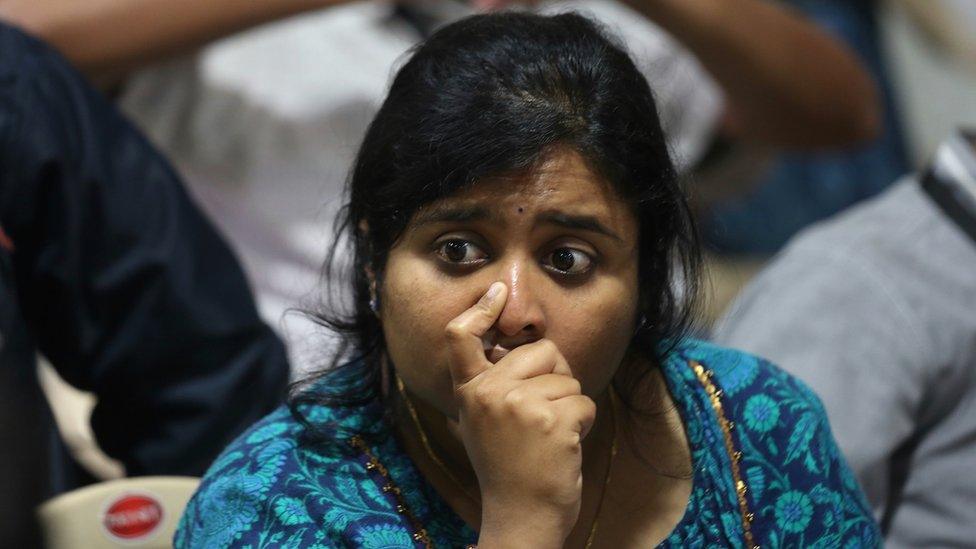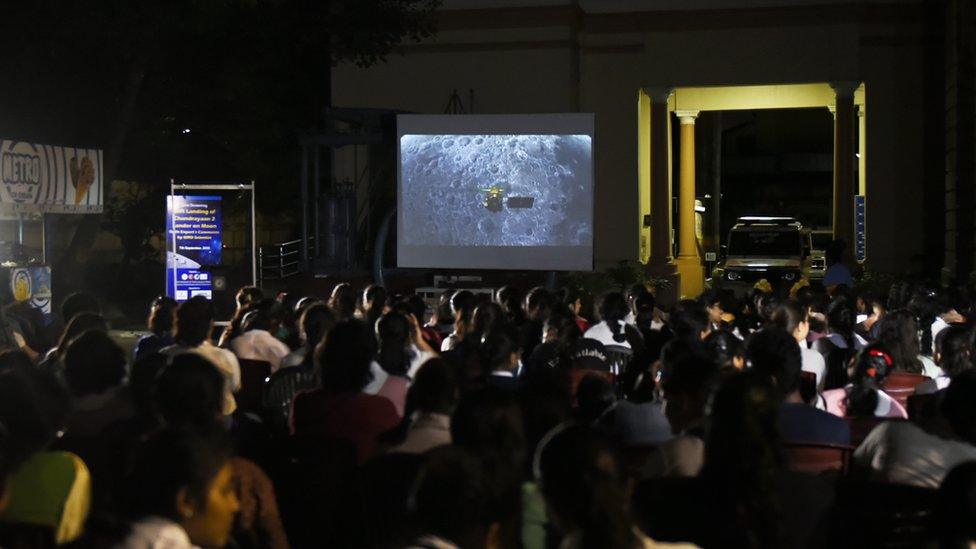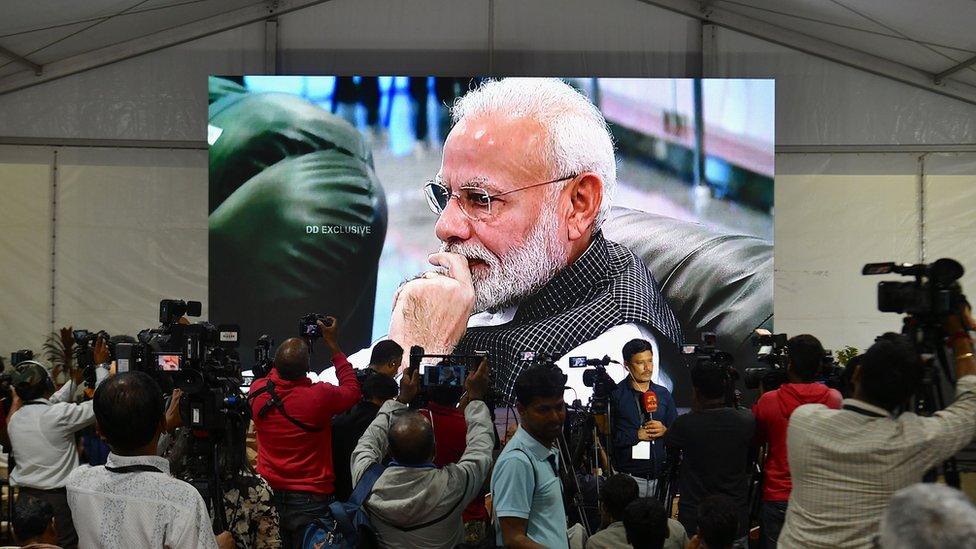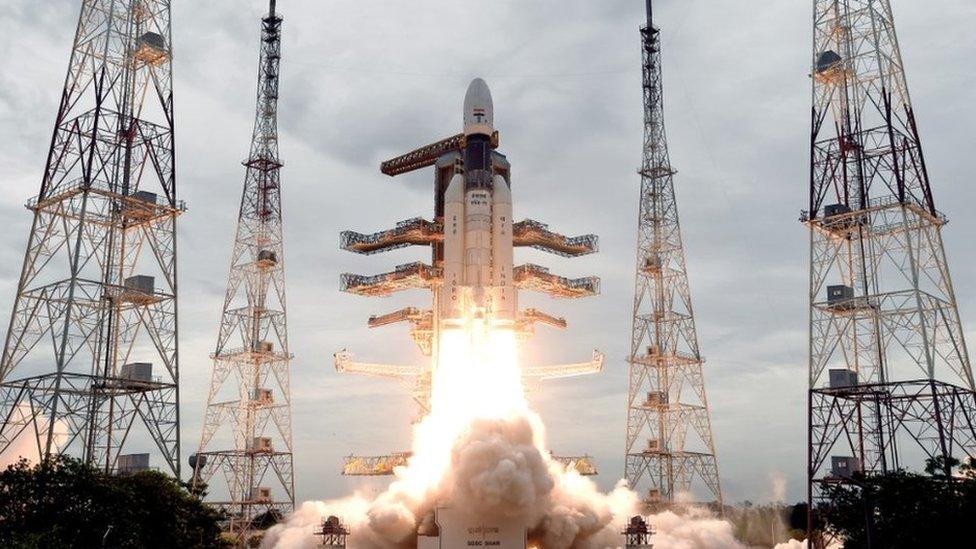Chandrayaan 2: What may have gone wrong with India's Moon mission?
- Published

Indian scientists say contact with the lander was lost seconds before it was scheduled to touch down
India's space agency, Isro, has not yet released information on how it lost contact with its Moon lander seconds before it was due to touch down on the lunar surface. But former members of the agency tell the BBC what may have gone wrong.
Chandrayaan-2 (Moon vehicle 2) entered the Moon's orbit on 20 August and was due to land on the lunar surface a little after midnight India local time (1800 GMT) on 7 September - a month after it first shot into space.
But contact was lost moments before the lander (named Vikram, after Isro founder Vikram Sarabhai) was expected to touch down at the lunar south pole.
The orbiter has since spotted the lander on the surface of the Moon - unbroken, but tilted on its side. So far, scientists have not been able to establish contact with it.

The event was watched by millions across India
The lander's final heart-stopping descent were monitored on screens, complete with readings which reflected the movement of the lander as it headed towards the surface of the Moon.
The screens carrying the readings also appeared on television and various social media accounts as the landing was broadcast live.
When the countdown began, the lander was moving at a velocity of 1,640 metres per second. Scientists say it appeared to be moving as planned during the first two phases of deceleration, known as the rough braking and fine braking operations.
It was during the final stage, known as the "hovering" stage, that the problem occurred.
The problem could well have been with the lander's central engine, according to Prof Roddam Narasimha, a former member of Isro. He said that his theory was based on the readings on the screen.
Modi consoles scientists after India Moon-lander loses contact
"One plausible explanation was that the lander started falling more rapidly," he told BBC Hindi's Imran Qureshi. "It's supposed to come down at a velocity of two metres per second when it hits the Moon's surface. But the gravity on the moon would have made it fall somewhat more rapidly.''
He believes this could be because the central engine was not "producing the thrust that is required and, therefore, the deceleration was no longer what it was supposed to be".
And this, in turn, may have led to eventually losing communication with the lander itself.
The head of India's first Moon mission, Mylswamy Annadurai, also said the anomaly in the velocity profile was an indication that something had malfunctioned in the lander as it hurtled towards the Moon.
"Most likely the orientation [of the lander] could have been disrupted. Once we look at the data we will be able to say for sure what happened, but it is likely that either a sensor or a thruster could have malfunctioned," he told BBC Tamil.

Prime Minister Narendra Modi also watched the event live
Dr Rajeswari Rajagopalan, the head of the Nuclear and Space Policy Initiative of the Observer Research Foundation (ORF), also said an engine malfunction was the likeliest reason.
"In the absence of data parameters, it is difficult to come to a conclusion, but the readings on the screen did show that something was wrong," she told BBC Hindi.
"The other possibility is that when you do a landing at a higher speed, you cause a lot of dust to rise that also shakes up the spacecraft because of the gravitational pull. But it's more likely the malfunctioning of one of the engines."
Chandrayaan-2 was the most complex mission ever attempted by Isro.
The lander carried within its belly a 27kg Moon rover (called Pragyan, which translates as wisdom in Sanskrit), which included instruments to analyse the lunar soil.
The rover had the capacity to travel 500m from the lander in its 14-day life span, and would have sent data and images back to Earth for analysis.
The mission would have focused on the lunar surface, searching for water and minerals and measuring moonquakes, among other things.
Is India a space superpower?

Read more about India's space ambitions
- Published7 September 2019

- Published6 September 2019
